水彩画《埃利斯门登霍尔桑德斯的房子在瑙沃伊利诺斯州”
一步一步的水彩画示范了罗兰•李
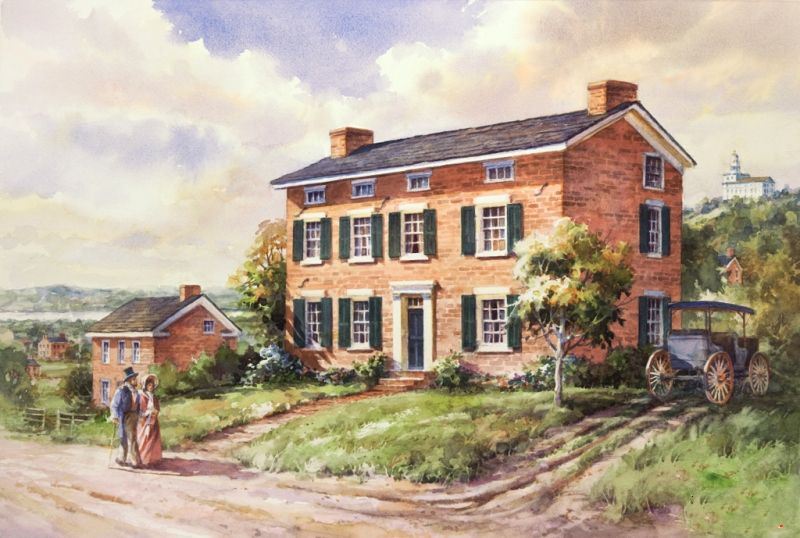
这个结构是一个保存最完好的古宅瑙沃。设计了主砖梅森,威廉·门登霍尔(其家是隔壁的绘画)家建立了埃利斯门登霍尔桑德斯和他的妻子,瑞秋扫帚罗伯茨——一个孙女的签名者的美国宪法。这是一个频繁的网站的后期圣徒教会教会会议和聚会。它于1843年开始兴建和桑德斯搬进这个房子1845年7月15日。然而,他们只生活在回家前10个月的圣徒被赶了出去,开始了他们的瑙沃著名西方陆路长途跋涉。今天它的功能作为一个床和早餐,我们有机会充分享受在我们呆在瑙沃。在这幅画,我用一个小艺术许可证来显示瑙沃庙在山上房子后面和视图在公寓到密西西比河在远处。
一步一步的绘画示范了罗兰•李
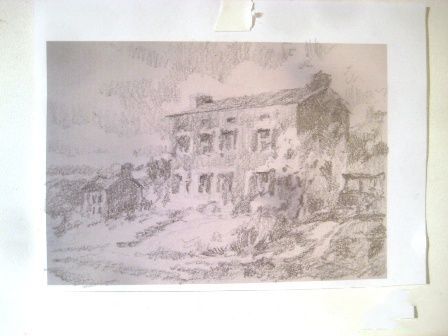
1。我的绘画总是首先草图和价值的研究。如果我让他们正确的开始,我80%确定这幅画会成功。这个小研究是关于3 x 5。通过保持我的第一个草图这小我避免诱惑,惹的细节。我担心这是设计,我如何可以使用值做出令人信服的场景。
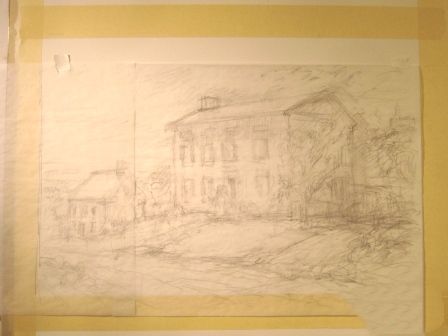
2。在这里,我使用描图纸画我的思想实际大小。跟踪纸让我尝试不同的想法和四处移动。我希望能获得在遥远的视图的密西西比河以及山上的寺庙,包括一些人物时期服装。你可以看看我画的人物都在门廊上以及在街上想看哪个效果最好。
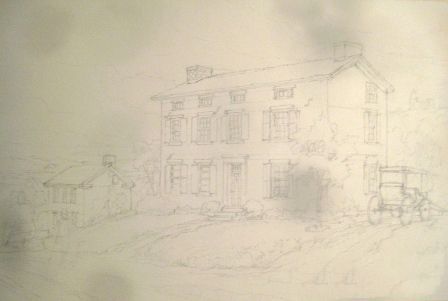
3。最后,我做的铅笔轮廓草图的水彩画纸将会作为我的向导当我试图控制应用程序的水彩釉料。
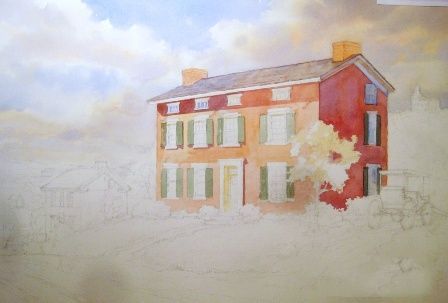
4。我开始运用油漆第一天空区域使用湿到湿技术,然后向下移动到房子面积。在这里我尝试建立灯光及深色和区域的光线和阴影。请注意我们已经可以感受到三维形状的房子,只是因为阴影。我将用三overglazes在某些领域得到我的富有的黑暗,但是我必须小心保护我所有的灯领域使用负绘画。在透明的水彩我不能油漆光明战胜了黑暗,所以这些地区从一开始就必须保存。
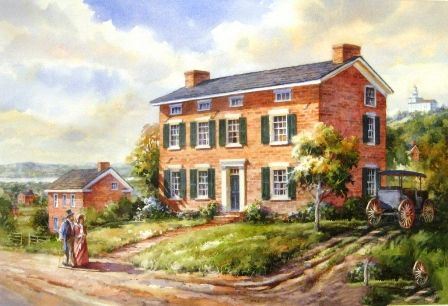
6。我使用同样的技术作为我继续工作在其余的绘画。你可以识别领域,我不得不漆四周,使用消极的绘画技术。注意眼睛总是吸引到地区最大的对比。
原文如下:
Watercolor Painting of "The Ellis Mendenhall Sanders House in Nauvoo Illinois"
Step by step watercolor painting demonstration by Roland Lee
This structure is one of Nauvoo’s best-preserved historic homes. Designed by master brick mason, William Mendenhall (whose home is next door in the painting) the home was built for Ellis Mendenhall Sanders and his wife, Rachel Broom Roberts - a granddaughter of a signer of the United States Constitution. It was a frequent site of LDS Church meetings and gatherings. Construction started in 1843 and the Sanders moved into the house on July 15, 1845. However, they only lived in the home for 10 months before the saints were driven out of Nauvoo, and started their famous overland trek west. Today it functions as a bed and breakfast, which we had the opportunity to fully enjoy during our stay in Nauvoo. In the painting, I used a little artistic license to show the Nauvoo Temple on the hill behind the house and the view across the flats to the Mississippi River in the distance.
STEP BY STEP PAINTING DEMONSTRATION BY ROLAND LEE
1. My paintings always begin with sketches and value studies. If I get them right at the outset, I am about 80% sure the painting will be successful. This little study is about 3 x 5. By keeping my first sketches this small I avoid the temptation to mess with details. What I am concerned about here is the design, and how I can use values to make a convincing scene.
2. Here I use tracing paper to sketch up my ideas actual size. The tracing paper allows me to try out different ideas and move things around. I am hoping to get in distant views of the Mississippi River as well as the Temple on the hill, and include some figures in period clothing. You can see how I've sketched figures both on the porch as well as in the street trying to see which works best.
3. Finally, I do a pencil outline sketch right on the watercolor paper which will act as my guide as I try to control the applications of watercolor glazes.
4. I begin applying paint first to the sky area using wet into wet techniques, then move down into the house area. Here I try to establish the lights and darks and the areas of light and shadow. Notice how we can already sense the three-dimensional shape of the house, just because of the shadows. I will use up to three overglazes in certain areas to get my richest darks, but I have to be careful to preserve all of my light areas by using negative painting. In transparent watercolor I cannot paint light over dark, so those areas must be saved from the start.
6. I use that same technique as I continue to work on the rest of the painting. You can identify the areas that I had to paint around, using the negative painting technique. Notice how the eye is always drawn to the areas of greatest contrast.








